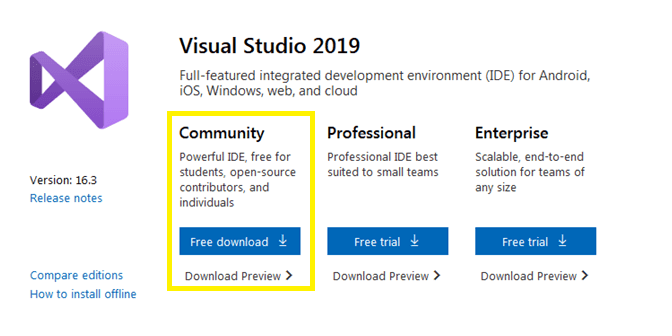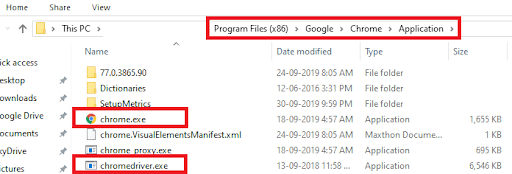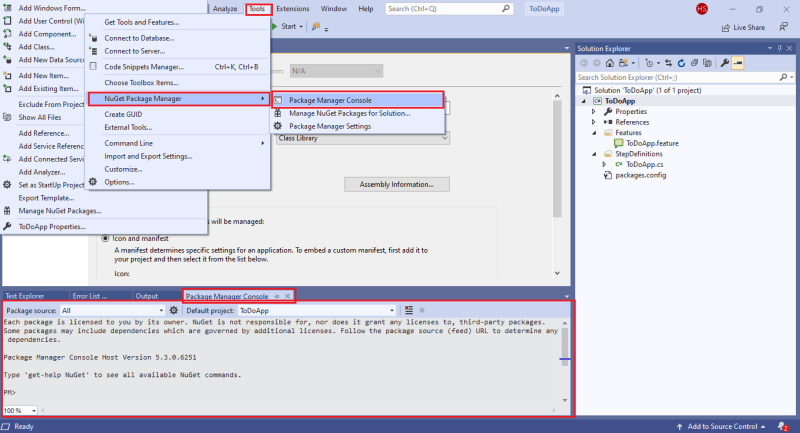Getting started with Selenium and C# is easy if you have the idea about connecting the right blocks for test code development. In one of the earlier blogs, we covered the Selenium WebDriver architecture in great detail. This is chapter 1 of the Selenium C# tutorial series where we are going to help you set up Selenium in Visual Studio for automated browser testing of your web-application.
In this Selenium C# tutorial, we are going to:
- Getting started with Visual Studio 2019 (including Installation)
- Downloading and installing Selenium WebDriver
- Creating our first Selenium C# project in Visual Studio
- Run our first Selenium C# test automation script
Site generator test cases are crucial as it ensures the generated code is error-free & adheres to industry standards, providing a seamless user experience.
Getting Started with Visual Studio 2019
Visual Studio is the best IDE (Integrated Development Environment) to use for Selenium C# test automation. In this Selenium C# tutorial, we will use the latest version of Visual Studio i.e. (VS 2019).
There are a number of download options available with VS 2019. The non-commercial version is Visual Studio Community, whereas the commercial versions are Visual Studio Professional & Visual Studio Enterprise. For the demonstration in this Selenium C# tutorial series, we would make use of the Community Edition of Visual Studio 2019 for Selenium test automation.
Install the necessary packages for Selenium C# test automation in your operating system.
Note: The license of the Community Edition expires after 30 days of usage. To extend the license, you should sign-in to the IDE. Signing-in also lets you use the other powerful features of Visual Studio such as pushing source code to private Git, syncing Visual Studio settings, and more.
Downloading & Installing Selenium WebDriver
Selenium WebDriver is one of the most popular open-source test automation framework used for automating web application testing. Selenium WebDriver helps to greatly reduce the efforts involved in cross browser testing by automating the test scripts.
Now, let’s install the Selenium WebDriver for the browser under test on your operating system. Shown below are the locations from where you can download the Selenium WebDriver for popular browsers.
- Opera - https://github.com/operasoftware/operachromiumdriver/releases
- Firefox - https://github.com/mozilla/geckodriver/releases
- Chrome - http://chromedriver.chromium.org/downloads
- Internet Explorer - https://github.com/SeleniumHQ/selenium/wiki/InternetExplorerDriver
- Microsoft Edge - https://blogs.windows.com/msedgedev/2015/07/23/bringing-automated-testing-to-microsoft-edge-through-webdriver/
In this Selenium C# tutorial, we will make use of the Google Chrome for automation testing with Selenium in Visual Studio.
Note: It is recommended to install the Selenium WebDriver executable in the location where the Google Chrome browser is present. That way, you need not mention the location of the Selenium WebDriver when invoking the same in your test implementation.
Our tutorial on Website Builder Test Case Templates offers comprehensive guide for effective website testing. Start optimizing your website’s quality today.
Creating our first NUnit Project for Selenium C# in Visual Studio
Now, you have installed Visual Studio 2019 along with the Selenium WebDriver for Google Chrome. You are all set to execute your first Selenium C# testing script through the NUnit framework.
NUnit is a test automation framework that helps to perform Selenium C# testing with much ease. In this chapter of the Selenium C# tutorial series, we will touch upon basic aspects of NUnit such as the installation of the framework along with installing the Selenium WebDriver for the test project. We will talk more about NUnit as we go forward. For now, let get your first Selenium C# example script running through NUnit.
You will need to create an NUnit project for running an automation script using Selenium in Visual Studio. Here are the steps to create an NUnit project for Selenium C# development:
Step 1: Create a new project of the type ‘NUnit Test Project (.Net Core)’ in Visual Studio.
Step 2: Give an appropriate name to the project and click Create.
Step 3: Since the project is of the type NUnit (.Net Core), the newly created .cs file will contain the basic functionalities of the NUnit framework.
Step 4: Install the Selenium WebDriver (for Google Chrome) and NUnit framework. Execute the appropriate Package Manager(PM) commands to install the necessary packages.
To execute PM commands from the PM console, navigate to Tools -> NuGet Package Manager -> Package Manager Console.
Execute these commands on the PM console to install Selenium in Visual Studio:
Install-Package Selenium.WebDriver
Install-Package Selenium.Chrome.WebDriver
Similarly, execute the following commands on the PM console to install NUnit:
Install-Package NUnit
Install-Package NUnit3TestAdapter
Below are some of the screenshots of the execution:
Step 5: To verify the status of the package installation, execute the Get-Package command on the PM console.
PM> Get-Package
Id Versions
-- --------
Selenium.WebDriver {3.141.0}
Selenium.Chrome.WebDriver {79.0.0}
...... ......
...... ......
Writing Your First Selenium C# Test Automation
In this section of Selenium C# tutorial, we look at the following test scenario:
- Navigate to the URL https://www.google.com.
- Locate the search-box on the page.
- Enter the search item as LambdaTest and click Google Search.
We are using a basic test scenario that uses the bare minimum annotations of the NUnit framework. It is just to get you started with Selenium test automation using a test framework like NUnit.
using NUnit.Framework;
using OpenQA.Selenium;
using OpenQA.Selenium.Chrome;
using System;
namespace Selenium_Demo
{
class Selenium_Demo
{
String test_url = "https://www.google.com";
IWebDriver driver;
[SetUp]
public void start_Browser()
{
// Local Selenium WebDriver
driver = new ChromeDriver();
driver.Manage().Window.Maximize();
}
[Test]
public void test_search()
{
driver.Url = test_url;
System.Threading.Thread.Sleep(2000);
IWebElement searchText = driver.FindElement(By.CssSelector("[name = 'q']"));
searchText.SendKeys("LambdaTest");
IWebElement searchButton = driver.FindElement(By.XPath("//div[@class='FPdoLc tfB0Bf']//input[@name='btnK']"));
searchButton.Click();
System.Threading.Thread.Sleep(6000);
Console.WriteLine("Test Passed");
}
[TearDown]
public void close_Browser()
{
driver.Quit();
}
}
}
As seen in the above implementation, the Chrome WebDriver is initiated in the code implemented under the [SetUp] attribute.
[SetUp]
public void start_Browser()
{
// Local Selenium WebDriver
driver = new ChromeDriver();
driver.Manage().Window.Maximize();
}
The test implementation is under the [Test] attribute. The necessary web elements are located using the Inspect Tool in Google Chrome.
[Test]
public void test_search()
{
driver.Url = test_url;
System.Threading.Thread.Sleep(2000);
IWebElement searchText = driver.FindElement(By.CssSelector("[name = 'q']"));
searchText.SendKeys("LambdaTest");
......................................
......................................
}
Now, you can execute the test using the IDE. The status of the tests can be seen using the Test Explorer in Visual Studio. For accessing Test Explorer, go to View 🡪 Test Explorer.
To build the project and execute all the tests, go to Test 🡪 Run All Tests. On successful execution, you would see a Green test in the Test Explorer window.
Over 57 different e-commerce test cases for websites and application are covered to guarantee a flawless and secure purchasing experience for customers.
Stay Tuned For Upcoming Chapters
In this article of the continuing Selenium C# tutorial series, we looked at the basic aspects like installing Selenium in Visual Studio along with running the first Selenium C# testing script. The test case using the NUnit framework gave a complete end-to-end demonstration. Stay tuned with the LambdaTest blog by hitting the bell icon. We look forward to having you back in the next chapter of this Selenium C# tutorial series where we will talk about Web Browser commands in Selenium C#. See you then & Happy Testing.!! 🙂















Top comments (0)